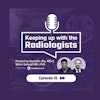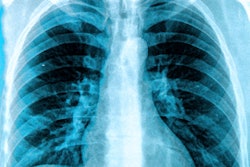AuntMinnie.com · Keeping Up With The Radiologists - Episode 3: AI in radiology, build, buy, neither
In this episode of the "Keeping Up With the Radiologists" podcast series brought to you by AuntMinnie.com in collaboration with Penn Radiology, Saurabh (Harry) Jha, MD; Mitchell Schnall, MD, PhD; Tessa Cook, MD, PhD; and Chuck Kahn, MD, address the shortcomings of AI in radiology in a spirited discussion.
Prashant Warier, PhD, co-founder and CEO of AI software developer QureAI, fields the brunt of the radiologists' constructive criticisms. The temperature rises a little in this episode. Like other medical imaging AI companies, QureAI is striving to win the hearts and minds of time-constrained radiologists who may still question the value of current AI offerings and otherwise remain skeptical and cautious.
Cook is a cardiovascular radiologist who is board-certified in clinical informatics. She also serves as co-director of Penn Medicine's Center for Practice Transformation in Radiology which develops and pilots innovation initiatives -- including AI -- for improving care delivery in radiology. Kahn is a radiologist and imaging informaticist at the University of Pennsylvania Perelman School of Medicine. He also serves as the editor of Radiology: Artificial Intelligence.
Every radiology practice has unique needs, said Cook and Kahn during the show, and Warier shows not an ounce of defensiveness over the state of his industry.
- Should you build radiology AI in-house or buy a ready-made product?
- What problem does Schnall encounter 500 times a day that AI hasn't offered to help with?
- What is private industry doing as part of radiology AI strategy and scale?
"That's really the thing," said Cook, "The needs of the market are so diverse. What we face as a challenge, and we've had this conversation with industry partners of, well, it's nice but it's not going to make a dent in our workflow."
On the other hand, Cook added, in different practice settings they say, "Well, we know we need help."
To the potential rescue, AI firms happily raise their hands. Where is it working? AI for stroke, lung nodules, and others too.
During the podcast, Cook advises. "Find one that works well, with whom you have a good relationship with the vendor, adapt it to your workflow, put it through its paces, especially if you find a vendor that's willing to take feedback and improve the performance of the system. So it really works well for you 100%. You're buying that. It doesn't make sense to reinvent the wheel and build something in-house and then be saddled with maintaining it."
Cook added that data drift will happen. Model performance will weaken. "AI is like anything else ... you calibrate it, you check on it."
How to "watch" for degradation in AI performance though. The panel antes up suggestions for discussion, among them:
- Postdeployment monitoring ... who's going to QC? That's the part that we're still figuring out, Cook said. "We need our industry partners to help us with that piece of it as well. That shouldn't be something that just relies entirely on the customer to make it successful." Listen for Warier weighing in.
- "Maybe the best model for this is to ask the laboratory pathologists," Schnall added, "the whole process under [Clinical Laboratory Improvement Amendments] CLIA that they go through to document and validate systems. This is something that has to become part of our DNA as radiology departments."
Radiologists' AI wish list: Cook asked for automatic aortic measurements. Computers are designed for that, she said. Jha added that the position of lines and tubes on chest x-rays. Only that's not as simple as it might sound -- for anyone. Why? Expert radiologists probably already know, but you'll hear more about it in this episode.
When it comes to AI in radiology, there is a lot of energy to innovate, and academic radiology departments have done incredible work. The challenge, Kahn said, then becomes not only keeping up the products but also taking what has been developed as a "project" and turning it into a "product." That's where he said a corporate partner can be valuable in scaling the AI to more sites or commercializing it.
Busy radiology departments that are considering how to deploy AI now or in the near future will want to tune in to this special build-or-buy AI episode of the "Keeping Up With the Radiologists" podcast. Listen now.
Impressions from this episode:
{02:57:00} Build it, buy it
{04:50:08} FDA clearance
{05:11:23} Corporate partners
{07:47:07} Back end of AI
{10:32:00} Economies of scale
{13:01:02} Transfer to commercial entity
{13:55:01} Adapting commercial systems
{15:12:01} Unique needs
{16:36:17} Overfitting
{18:21:18} Postdeployment monitoring
{19:13:18} QC
{26:15:24} AI overhead
{27:16:08} Value of AI
{29:33:11} Comprehensive functionality
{33:01:05} Marketplace approach
{35:19:14} Context of prior imaging
{39:55:14} Efficiency gains
{41:01:05} QureAI in U.S.
{48:29:19} What industry needs
{49:01:19} Radiology practice needs
Mentions:
Saurabh (Harry) Jha
Mitchell Schnall
Penn Medicine
University of Pennsylvania
Tessa Cook
Chuck Kahn
Prashant Warier
Qure.ai
Special guest:
Prashant Warier is co-founder and CEO of QureAI. Warier is a data scientist by training and has been building algorithms for about 22 years.
Featured:
Saurabh (Harry) Jha, MD, is an associate professor of radiology at the Hospital of the University of Pennsylvania. Jha obtained a master’s degree in health policy research from the Leonard Davis Institute at the University of Pennsylvania. He earned his medical degree from the United Medical and Dental Schools of Guy’s, King’s, and St. Thomas’ Hospitals. Jha developed Value of Imaging, a set of radiology educational resources.
Mitchell Schnall, MD, PhD, is a physician at Penn Medicine in its abdominal imaging services program. Chair of the department of radiology and the Eugene P. Pendergrass Professor of Radiology at the Perelman School of Medicine, Schnall has served as the group co-chair of the ECOG-ACRIN Cancer Research Group since its founding in 2012. He is an international leader in translational biomedical and imaging research, working throughout his career across the interface between basic imaging science and clinical medicine to ensure effective integration of radiology research with other medical disciplines.
Tessa Cook, MD, PhD, is a cardiovascular radiologist and board-certified clinical informaticist at Penn Medicine. Cook serves as co-director of Penn Medicine's Center for Practice Transformation in Radiology which develops and pilots innovation initiatives looking for improving care delivery in radiology. That includes AI.
Chuck Kahn, MD, is a radiologist at the University of Pennsylvania. Khan serves as vice chair of the department and looks after matters related to informatics and information technology. His personal interests are in information systems, decision support, artificial intelligence, and health services research.
This episode of Keeping Up With the Radiologists is brought to you by AuntMinnie.com in collaboration with Penn Radiology. The series is also available on Spotify and Apple Podcasts. Check back for new episodes!




















